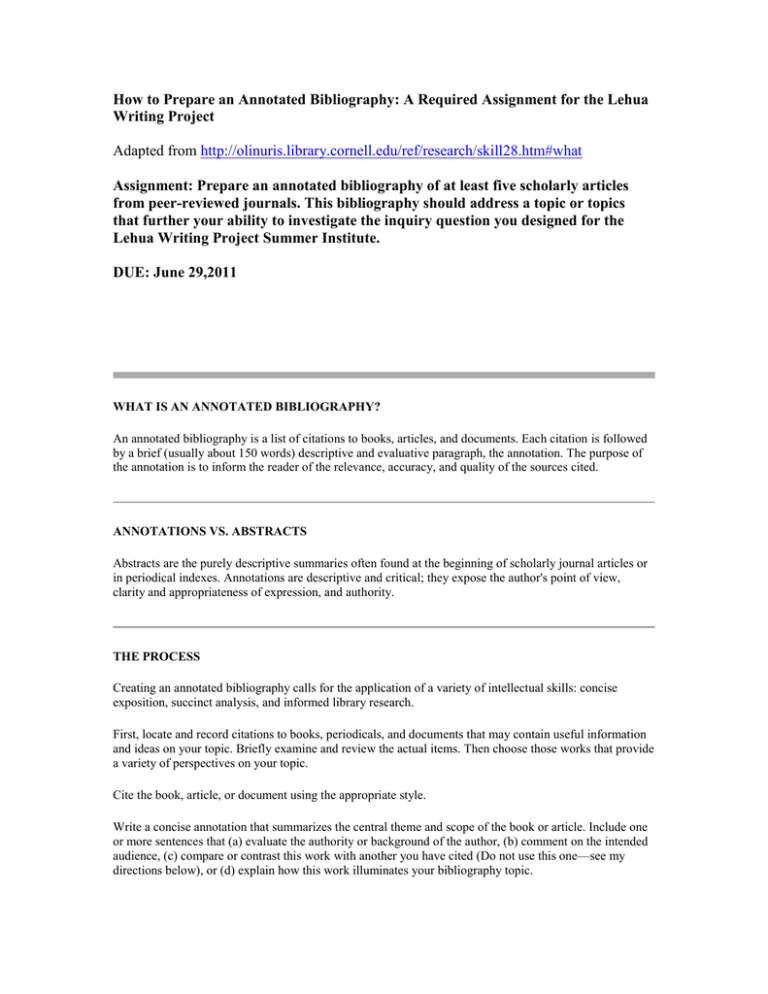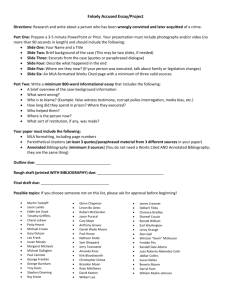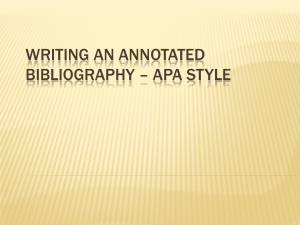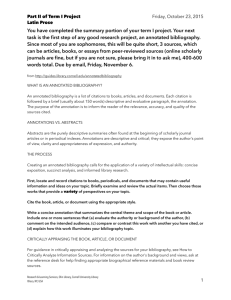How to Prepare an Annotated Bibliography
advertisement

How to Prepare an Annotated Bibliography: A Required Assignment for the Lehua Writing Project Adapted from http://olinuris.library.cornell.edu/ref/research/skill28.htm#what Assignment: Prepare an annotated bibliography of at least five scholarly articles from peer-reviewed journals. This bibliography should address a topic or topics that further your ability to investigate the inquiry question you designed for the Lehua Writing Project Summer Institute. DUE: June 29,2011 WHAT IS AN ANNOTATED BIBLIOGRAPHY? An annotated bibliography is a list of citations to books, articles, and documents. Each citation is followed by a brief (usually about 150 words) descriptive and evaluative paragraph, the annotation. The purpose of the annotation is to inform the reader of the relevance, accuracy, and quality of the sources cited. ANNOTATIONS VS. ABSTRACTS Abstracts are the purely descriptive summaries often found at the beginning of scholarly journal articles or in periodical indexes. Annotations are descriptive and critical; they expose the author's point of view, clarity and appropriateness of expression, and authority. THE PROCESS Creating an annotated bibliography calls for the application of a variety of intellectual skills: concise exposition, succinct analysis, and informed library research. First, locate and record citations to books, periodicals, and documents that may contain useful information and ideas on your topic. Briefly examine and review the actual items. Then choose those works that provide a variety of perspectives on your topic. Cite the book, article, or document using the appropriate style. Write a concise annotation that summarizes the central theme and scope of the book or article. Include one or more sentences that (a) evaluate the authority or background of the author, (b) comment on the intended audience, (c) compare or contrast this work with another you have cited (Do not use this one—see my directions below), or (d) explain how this work illuminates your bibliography topic. To simplify this process, think of these questions using the reporter’s formula (Jeannine’s Directions): A) WHO wrote this article? What are his, her, or their credentials? How are he/she/they an authority in the topic of study in this article? B) For WHAT audience was this article written? C) WHEN was this article written? How current is it in relationship to other literature you have seen on the topic you are researching? D) WHY was the article written? Summarize the central theme. Examine the inquiry question or hypothesis? Briefly discuss the methodology utilized. (Participants, method of data collection, method of analysis) E) WHERE was the study conducted? CRITICALLY APPRAISING THE BOOK, ARTICLE, OR DOCUMENT For guidance in critically appraising and analyzing the sources for your bibliography, see How to Critically Analyze Information Sources. For information on the author's background and views, ask at the reference desk for help finding appropriate biographical reference materials and book review sources. Return to the top APA Formatting: You will use APA formatting to construct your annotated bibliography. For comprehensive tutorials, resources, and help on how to use APA, please use go to the OWL PURDUE: http://owl.english.purdue.edu/owl/resource/560/05/. In the bottom left hand corner of the page, you will see a PowerPoint, flash movie tutorials, podcasts, and exercises. SAMPLE ANNOTATED BIBLIOGRAPHY ENTRY FOR A JOURNAL ARTICLE The following example uses the APA format for the journal citation. Waite, L. J., Goldschneider, F. K., & Witsberger, C. (1986). Nonfamily living and the erosion of traditional family orientations among young adults. American Sociological Review, 51 (4), 541-554. The authors, researchers at the Rand Corporation and Brown University, use data from the National Longitudinal Surveys of Young Women and Young Men to test their hypothesis that nonfamily living by young adults alters their attitudes, values, plans, and expectations, moving them away from their belief in traditional sex roles. They find their hypothesis strongly supported in young females, while the effects were fewer in studies of young males. Increasing the time away from parents before marrying increased individualism, self-sufficiency, and changes in attitudes about families. In contrast, an earlier study by Williams cited below shows no significant gender differences in sex role attitudes as a result of nonfamily living. Please look for your articles on line in the Mookini Library http://library.uhh.hawaii.edu/ You may consider using RefWorks (http://library.uhh.hawaii.edu/research_tools/refworks.html) to help you organize your citations. Please go through Mookini Library page to do this and not straight to RefWorks. You will need to validate your ID through Distance Learning to use this site:




